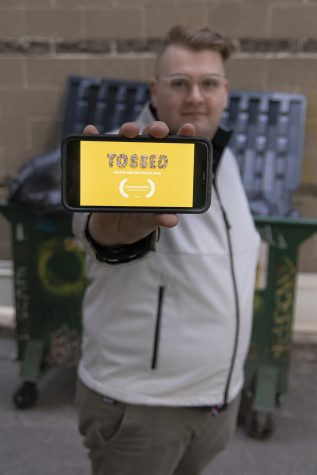Student’s interactive video challenges waste disposal notions
March 21, 2020

Television major Patrick Thomas Keen’s interactive video “Tossed” encourages Chicago citizens to dispose of waste properly. It received an honorable mention in the One Earth Film Festival.
What do greasy pizza boxes, disposable coffee cups and oily takeout containers all have in common? They are often mistaken to be recyclable.
According to an April 2019 survey of 2,000 Americans by Covanta, a New Jersey-based waste management company, 62% of respondents were worried they did not know how to recycle correctly.
To satisfy this lack of education, junior television major Patrick Thomas Keen created “Tossed,” an interactive video meant to teach viewers about proper waste disposal methods in Chicago.
Hosted by sophomore interdisciplinary major Marcus Sampson, the video presents viewers with different types of waste and prompts them to select the proper receptacle by clicking a link to one of several different videos. Depending on their answer, they are sent to a new screen that either congratulates them on a correct answer or explains why their answer was wrong.
After earning an honorable mention in the One Earth Film Festival Young Filmmakers Contest, the video was screened March 7 at the Gene Siskel Film Center as part of the annual festival. A secondary screening scheduled for Saturday, March 14 was postponed due to closures related to the coronavirus.
Keen said the decision to make the interactive video came from a desire to avoid the “preachy” nature of some environmental activism, instead focusing on giving the viewer a personal experience.
“It’s not meant to judge you. It’s meant to inform you,” he said.
Sue Crothers—a founding member of the One Earth Film Festival and founding director and co-chair of the Young Filmmakers Contest—said “Tossed” was the only interactive entry to win an award in the competition.
“We have a theme every year, and this year’s was ‘The Power of We.’ It was really interesting to us because it is putting the power into the person [watching] to actually become part of the narrative,” Crothers said.
Unlike the other films in the festival, “Tossed” was presented in a mobile app demonstration so audience members could individually engage with the interactive video.
“What was really great about this interactive piece that he did, and something really unique for us, is that there was no shaming when you went to the wrong spot,” Crothers said. “Instead, it got deeper into the education in a really fun, engaging way.”
Keen said he had the idea for “Tossed” long ago, but the “Video for Internet and Mobile TV” class gave him the tools to produce and distribute the project.
The resources needed to make this type of interactive media are limited because it is such a new development, Keen said.
“It’s such an emerging form of media that it’s even hard to teach about,” he said. “It’s changing every day.”
“Tossed” was originally intended for Columbia students and was published on Frequency TV’s website. Now that it has received more widespread attention, Keen said he has made edits to expand its audience to all Chicago residents. Some of the waste disposal methods discussed in “Tossed” may not apply outside of Chicago, he said.
“Recycling with waste is so dictated by the region in which you operate. Different objects are recyclable here, but not there, and vice-versa,” Keen said.
“When something goes in the trash, you don’t see the trash collector; you don’t see the recycling collector. It’s out of your hands … so it’s easy to overlook what decisions are being made and what sort of impact that your waste habits have,” Keen said. “This film challenges that notion.”







